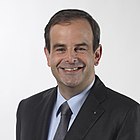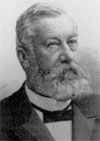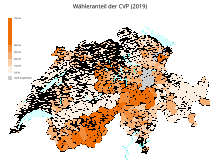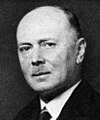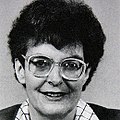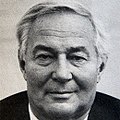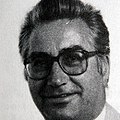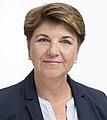Christian Democratic People's Party
| Christian Democratic People's Party | |
|---|---|

|
|
| Establishment date: | April 22, 1912 |
| Place of foundation: | Ruswil |
| Ideology: |
Christian Democracy , Sociopolitical Conservatism |
| Presidium: | Gerhard Pfister |
| Vice Presidium: | Ida Glanzmann |
| Secretary General: | Gianna Luzio |
| Members of the Federal Council: | Viola Amherd |
| Members: | 100,000 (as of 2014) |
| Proportion of women: | in the National Council : 28% in the Council of States : 36.4% (as of: NR elections 2019) |
| Share of voters: | 11.4% (as of: NR elections 2019) |
| National Council: |
25/200 |
| Council of States: |
13/46 |
| Fraction (BV): | Middle group. CVP-EVP-BDP |
| Group President: | Andrea Gmür-Schönenberger |
| Cantonal parliaments: |
404/2609 (As of November 2019) |
| Cantonal Governments: |
38/154 (As of November 2019) |
| Groupings: |
CVP Women Young CVP Christian Social Party Working Group Economy and Society Forum politique suisse Forum de l'entreprise |
| Home address: | Hirschengraben 9 3011 Bern |
| International connections: | Christian Democratic International |
| European party: | European People's Party (associated) |
| Website: | www.cvp.ch |
The CVP Switzerland - Christian Democratic People's Party (Fr .: Parti démocrate-chrétien (PDC), Ital .: Partito Popolare democratico svizzero (PPD), rätorom .: Partida cristiandemocratica Svizra PCD) - is one of the four Swiss government parties and since 1891 Federal represent . In the early days of the Swiss federal state, with its predecessor movements, it was the basin of the Catholic conservative forces and the main opposition to the liberal spirit that dominated the state . However, it is now in the middle of the political spectrum and represents Christian Democratic positions.
Content profile
The CVP describes itself in its party program as liberal-social, whereby it wants to combine liberal principles with the guarantee of basic social rights in the sense of the so-called social market economy . The CVP sees itself as a representative for families and small and medium-sized companies. It also wants to strengthen medium-sized businesses.
The expansion of the party into the reformed cantons, in which the CVP pursues what it sees as a social and liberal policy, contrasts with the traditional role of the CVP as a state-supporting party in the Catholic home countries ( Central Switzerland , Valais , Ticino ); there the voter base is still made up of rather conservative citizens. Another reason is the dominance of the party in its home countries - in the canton of Lucerne it had three out of five members of the government until 2005, in Valais it is still the case - which forces a consensus course.
Main political issues
As a state-sponsoring party, the CVP sees itself as the central bridge-builder in Switzerland's federal system, which is based on compromise and concordance. Politics should be solution-oriented and future-oriented. The CVP's policy covers all topics relevant to state policy (education and research, family, agriculture, public services and transport, security and state policy and law), but in the 2019 election year it will focus on the following areas:
- Health : The CVP wants to counteract the high and rising costs of the health care system with a cost brake initiative. The party states that 20% or 6 billion francs of the costs can be saved in the compulsory basic insurance without any loss of quality. The initiative is intended to relieve all premium payers, in particular small and medium-sized businesses and families. This is to be implemented, among other things, through lower drug prices, more outpatient instead of inpatient treatments and the advance installation of the electronic patient record.
- Climate and environment : In 1971, at the initiative of the CVP, the environmental article was included in the federal constitution. Today the party calls for the use of domestic and renewable energy sources, the expansion of cleantech and a handy CO 2 law for the consistent implementation of the energy transition.
- Foreign policy : The CVP calls for a Switzerland that is neutral and sovereign, but not isolated. To this end, it demands close economic and socially sustainable relationships with partners and, above all, a self-confident demeanor towards the EU, especially during the required renegotiations on the institutional framework agreement.
- Social services : In order to guarantee secure pensions in the future, the CVP calls for reforms to the AHV and the second pillar as well as a flexible retirement age, whereby the reference age of women should be aligned with that of men. This demand is supported by the CVP women with the link between equal pay and that the costs should not be borne by women. In order to further relieve the social welfare works, the CVP also demands better financial compensation for family carers. To implement this requirement, representatives of the CVP initiated a new federal law on the improvement of the reconciliation of gainful employment and caring for relatives. Further measures relating to social welfare services concern the prevention of abuse and reforms in the financing of the second pillar.
- Sustainable economy : The CVP takes the perspective that only an economic policy that is growth-friendly and based on solidarity creates prosperity. She advocates low-cost childcare, two weeks of paternity leave, equal pay and flexible work models for a better work-life balance. In the so-called family initiative, the CVP fought for child and education allowances to be exempt from taxes. In addition, tax disadvantages for married couples and in registered couples are to be eliminated. The party has campaigned for this with a popular initiative. The CVP sees itself as the party that strengthens small and medium-sized enterprises and SMEs. The latter should benefit from optimal framework conditions in order to continue to grow and to be able to offer high-quality vocational training. The CVP also advocates strengthening the Swiss financial center and making use of the opportunities offered by the digital future.
- Migration : The party focuses on the rapid and sustainable social integration of migrants admitted to Switzerland. In doing so, the CVP wants to preserve the Swiss values of living together and to hold discussions about these values with people from other cultures. At the same time, targeted development aid in the countries of origin is intended to reduce the number of people seeking help. The aim of the measures is an asylum policy that does not allow abuse.
Party organs
- Assembly of delegates: The highest body at federal level is the assembly of delegates (party congress), in which the cantonal parties are represented. They define party politics and elect the officials at the federal level.
- Party executive committee : The leading and executive organ of the party is the executive committee. This consists of the members of the party presidium, five members of the parliamentary group, two people per recognized association and one woman and one man per cantonal party.
- Presidium: The Presidium of CVP Switzerland consists of the following people:
| Party president | Gerhard Pfister |
| Vice-President | Ida Glanzmann-Hunkeler , Charles Juillard |
| President of the Center Group. CVP-EVP-BDP | Andrea Gmür-Schönenberger |
| Other members of the presidium | Marianne Binder-Keller , Pirmin Bischof , Martin Candinas , Filippo Lombardi , Stefan Müller-Altermatt , Tino Schneider , Elisabeth Schneider-Schneiter , Anne Seydoux-Christe |
- General Secretariat: The General Secretary is Gianna Luzio .
Gerhard Pfister , party president since 2016
Ida Glanzmann-Hunkeler , Vice President since 2008
Charles Juillard , Vice President
Andrea Gmür-Schönenberger , parliamentary group president since 2020
Representation in government and parliaments
- Bundesrat: The CVP has always been represented in the Bundesrat since 1891 . CVP Federal Councilor Viola Amherd is currently Switzerland's first female defense minister as Head of the Federal Department of Defense, Civil Protection and Sport (DDPS).
- Federal Chancellor Walter Thurnheer
- Parliamentary parliamentary group : All incumbent National Councilors and Councilors of States of the CVP (40), EPP (2) and CSP (1) were represented in this group. With 43 seats, it was the fourth largest parliamentary group in the federal council. Of these, 29 seats went to the National Council and 14 to the Council of States. The CVP was thus the strongest party in the Council of States; the parliamentary group was led by parliamentary group president Filippo Lombardi and vice-parliamentary group president Leo Müller . The successor parliamentary group is the middle parliamentary group. CVP-EVP-BDP , which has been led by Andrea Gmür-Schönenberger since 2020 .
- Cantonal governments: the CVP has 38 government councilors in a total of 22 cantons. This corresponds to 24.7% of all seats.
- Cantonal parliaments: It is represented in all cantonal parliaments with a total of 414 mandates. This corresponds to 15.9% of all seats.
Viola Amherd , Federal Councilor since 2019
Walter Thurnherr , Federal Chancellor since 2016
Associations of the CVP
The CVP has the following associations:
- CVP women
- Young CVP
- Working Group Economy and Labor (AWG)
- Forum de l'entreprise
- Forum politique
- Christian Social Association Switzerland (CSV), successor organization to the Christian Social Party (CSP)
Cantonal Sections
| Cantonal Section | president |
Results of the National Council elections 2019 |
Mandates in the National Council | Mandates in the Council of States |
|---|---|---|---|---|
| CVP Canton Aargau | Marianne Binder-Keller | 9.9% |
Ruth Humbel Näf Marianne Binder-Keller |
- |
| CVP Canton of Appenzell Ausserrhoden | Claudia Frischknecht | - | - | - |
| CVP Canton of Appenzell Innerrhoden | Ruedi Angehrn | 35.7% | Thomas Rechsteiner | Ivo Bischofberger |
| CVP Canton of Basel-Country | Silvio Armando Fareri | 8.5% | Elisabeth Schneider-Schneiter | - |
| CVP Canton of Basel-Stadt | Courtship Herter | 4.6% | - | - |
| CVP Canton of Bern | Alexandra Perina-Werz | 1.9% | - | - |
| CVP Canton of Friborg | André Schoenenweid | 17.8% |
Marie-France Roth Pasquier Christine Bulliard-Marbach |
- |
| CVP Canton of Geneva | Sébastien Desfayes | 7.7% | Vincent Maitre | - |
| CVP Canton of Glarus | Peter Landolt-Fischli | - | - | - |
| CVP Canton of Graubünden | Stefan Engler | 16.3% | Martin Candinas | Stefan Engler |
| CVP Canton of Jura | Martial Courtet | 22.5% | Jean-Paul Gschwind | Anne Seydoux-Christe |
| CVP Canton of Lucerne | Christian Ineichen | 25.5% |
Priska Wismer-Felder Ida Glanzmann-Hunkeler Leo Müller |
Andrea Gmür |
| CVP Canton Neuchâtel | Vincent Pahud | 4.2% | - | - |
| CVP Canton of Nidwalden | Therese Rotzer | 35.8% | - | - |
| CVP Canton Obwalden | Christoph Amstad-Bucher Bruno von Rotz |
36.7% | - | Erich Ettlin |
| CVP Canton Schaffhausen | Marco Rutz | 2.1% | - | - |
| CVP Canton Schwyz | Andreas Meyerhans | 18.4% | Alois Gmür | Othmar Reichmuth |
| CVP Canton of Solothurn | Sandra Kolly-Altermatt | 14.2% | Stefan Müller-Altermatt | Pirmin Bishop |
| CVP Canton of St. Gallen | Patrick Dürr | 18.8% |
Nicolo Paganini Markus Ritter |
Benedict Würth |
| CVP Canton Ticino | Giovanni Jelmini | 18.2% |
Fabio Regazzi Marco Romano |
- |
| CVP Canton Thurgau | Gallus Müller | 12.7% | Christian Lohr | Brigitte Häberli-Koller |
| CVP Canton of Uri | Frieda Steffen | 39.2% | Simon Stadler | Heidi Z'graggen |
| CVP Canton of Vaud |
Claude Béglé Axel Marion |
2.4% | - | - |
| CVP Canton of Valais | Anton Andenmatten (Upper Valais) Serge Metrailler (Lower Valais) |
34.8% |
Sidney Kamerzin Benjamin Roduit Philipp Matthias Bregy |
Beat Rieder Marianne Maret |
| CVP Canton of Zug | Martin Pfister | 23.8% | Gerhard Pfister | Peter Hegglin |
| CVP Canton of Zurich | Nicole Baradun-Gross | 4.4% | Philipp Kutter | - |
- Remarks
- ↑ The cantonal party is divided into four subsections: CVP Oberwallis , CVP Mittelwallis, CVP Unterwallis and CSP Oberwallis
history
Catholics in the Kulturkampf
The Gasthaus Rossli in Ruswil , representatives of conservative Popular Movement 1840 peasant leader Josef Leu of Ebersol , the Ruswiler declaration that opposed the liberal zeitgeist. A little later, the " Ruswiler Verein " was founded in the same tavern , which later became the Catholic Conservative Party, which throughout the 19th century took a church-friendly and a federalist stance in the cultural struggle . The Catholic Conservatives were defeated in the Sonderbund War of 1847 and subsequently found themselves in clear opposition to the liberal majority in the federal state founded in 1848.
In contrast to the situation in the state as a whole dominated Catholic - Conservative politics in the rural Catholic cantons of central Switzerland , in Valais and Friborg , while in the Ticino gave a lengthy power struggle with the liberals. Like the Liberals, the Catholic Conservatives had neither a formal organizational statute nor a program. In 1882 the parliamentary group was officially founded. Attempts to found a national party (1874 “ Association conservatrice suisse ” by Abbé Joseph Schorderet and Theodor Scherer-Boccard , 1881 “ Conservative Union ” by Josef Zemp and Julius Schnyder von Wartensee , 1894 “ Catholic People's Party ” by Anton Augustin and Ernst Feigenwinter ) failed For decades on the federal structure of Switzerland and the differences in the Catholic-conservative camp.
The process of integrating the Catholic Conservatives into the liberal federal state began at the end of the 19th century. After several victories by the Catholic Conservatives, which they had won in various alliances, the liberals and radicals realized that their policy of isolation could no longer be maintained. In addition, with the rise of social democracy, they preferred a solidarity between the bourgeoisie . On December 17, 1891, Josef Zemp, a Catholic conservative, was elected to the Federal Council for the first time . Another important development at the turn of the century was that in addition to the traditional rural Catholic wing, a Christian social workers wing emerged, which found particularly strong support from Catholics who had emigrated to Protestant cantons, where the party was able to establish itself for the first time.
Catholic Conservatives in the interwar period
| Election year |
Share of voters |
National Council | Council of States |
|---|---|---|---|
| 1919 | 21.0% |
41/189 |
17/44 |
| 1922 | 21.0% |
44/198 |
17/44 |
| 1925 | 20.9% |
42/198 |
18/44 |
| 1928 | 21.4% |
46/198 |
18/44 |
| 1931 | 21.4% |
44/187 |
18/44 |
| 1935 | 20.3% |
42/187 |
19/44 |
| 1939 | 17.0% 1 |
43/187 |
18/44 |
| 1943 | 20.8% |
43/194 |
19/44 |
| 1947 | 21.2% |
44/194 |
18/44 |
| 1951 | 22.5% |
48/196 |
18/44 |
| 1955 | 23.2% |
47/196 |
17/44 |
| 1959 | 23.3% |
47/196 |
17/44 |
| 1963 | 23.4% |
48/200 |
18/44 |
| 1967 | 22.1% |
45/200 |
18/44 |
| 1971 | 20.3% |
44/200 |
17/44 |
| 1975 | 21.1% |
46/200 |
17/44 |
| 1979 | 21.3% |
44/200 |
18/46 |
| 1983 | 20.2% |
42/200 |
18/46 |
| 1987 | 19.7% |
42/200 |
19/46 |
| 1991 | 18.0% |
37/200 |
16/46 |
| 1995 | 16.8% |
34/200 |
16/46 |
| 1999 | 15.8% |
35/200 |
15/46 |
| 2003 | 14.4% |
29/200 |
15/46 |
| 2007 | 14.5% |
31/200 |
15/46 |
| 2011 | 12.3% |
29/200 |
13/46 |
| 2015 | 11.6% |
28/200 |
13/46 |
| 2019 | 11.4% |
25/200 |
13/46 |
|
1Meaningfulness limited, as silent voting in 9 cantons.
|
|||
In 1912, the " Swiss Conservative People's Party " (KVP) was founded in the Hôtel Union in Lucerne , the Catholic Conservatives were thus linked for the first time in a formal Swiss organization, which in 1919 received a second seat in the Federal Council with Jean-Marie Musy . With the founding of the Christian Social Workers' Union in 1919, the Christian Social Workers' and White-collar Workers' Movement gained in importance in the party, which had previously been peasant, industrial and small-town. In the interwar period, models of an “authoritarian democracy” and even corporate state ideas found a certain support within the Conservative People's Party . The climax of this tendency was the so-called revision initiative , which was launched by parts of the Catholic conservatives together with the right-wing extremist fronts . After the clear rejection of this request in the referendum in 1935, the corporatist movement subsided again.
In the mid-1930s, the class struggle between the bourgeoisie and the social democrats took a back seat under the pressure of fascism and led to a political normality between the ruling bourgeois parties - FDP, KVP and BGB - and the social democrats. In 1943 the Liberals lost the government majority in the Federal Council. In the same year, the CIP received the post of Federal Chancellor for the first time .
Bloom in the 1950s and renewal
Supported by the political climate of the post-war period, the conservatives experienced a high point in the 1950s: They provided the largest parliamentary delegation in their history, and from 1954 to 1958 the party occupied a third seat in the Federal Council, which they did, however, as part of the integration of the Social Democrats in 1959 The Swiss system of government gave up again and was guided by the magic formula . With 23.4 percent in the Swiss parliamentary elections in 1963 , the party achieved the best result in its party history.
In 1957, the Conservative People's Party was renamed “ Conservative-Christian Social People's Party ” (KCV), as the state party comprised conservative or Christian social cantonal parties depending on the canton. After the Second Vatican Council from 1962 to 1965, the party called for adjustment to the changed society and the KCV implemented a programmatic opening that led to the party reforms of 1970/1971. The new center party often formed a coalition with the Social Democrats in social policy and with the Liberals in economic and financial policy , while it represented Christian conservative positions in cultural and church policy . A new name for the party was also sought during the reforms: some suggested the “ Christian Democratic Union ”, while other forces wanted to break out of the “ Catholic ghetto ” and suggested the name “ Swiss People's Party ”. (Today's Swiss People's Party was only founded a year later). In 1970 the decision was finally made to use the current name « Christian Democratic People's Party ». In the following decades the CVP was able to maintain its share of the vote, but the dissolution of the Catholic milieu , once the unifying bracket of the party, caused increasing problems.
Decline in the proportion of voters and loss of a Federal Council seat
Although the CVP assumed a dominant position in its home countries, the former Sonderbund cantons of Lucerne , Friborg , Wallis , Uri , Schwyz , Obwalden , Nidwalden and Zug and (since the beginning of the 20th century) in the canton of St. Gallen , it came from the 1980s Years of erosion caused by secularization, social mobility, the affluent society and the dissolution of the Catholic milieu. From 1980 onwards, the decline in the number of regular voters led to a steady decline in the results achieved in the federal elections. In the 1990s and early 2000s in particular, many conservative voters from their rural homeland were lured away by the national-conservative SVP .
In the Federal Council election on December 10, 2003 , the ultimate demand by the Swiss People's Party for a second seat for its candidate Christoph Blocher broke the magic formula for the composition of the Federal Council . For the first time in a long time, a member of the Federal Council was no longer confirmed by the United Federal Assembly in a campaign election with the election of incumbent Federal Councilor Ruth Metzler-Arnold . Christoph Blocher was elected in her place. So Joseph Deiss remained as the only CVP representative in the Federal Council.
Recent developments
Under the leadership of its President and later Federal Councilor Doris Leuthard , the CVP was able to temporarily halt its decline in the mid-2000s. Swiss media spoke of the Leuthard Effect . In the Swiss parliamentary elections in 2007 , the CVP was able to slightly improve its share of the vote. The CVP then formed a joint parliamentary group with the glp and the EPP for the 48th legislative period of the National Council (after the glp itself reached parliamentary strength in 2011, it became the CVP / EPP parliamentary group of the Federal Assembly ). A strengthening of the political center, combined with a claim to leadership in this, was cited as the basis for this. As a result, the CVP also worked in various cantons and municipalities with the EPP and glp as well as with the BDP , which was founded in 2008 as an SVP spin-off .
The CVP has been losing votes again since the beginning of the 2010s. In the Swiss parliamentary elections in 2015 , the CVP received 11.6% of the vote and won 27 seats in the National Council and 13 Council of States, in those of 2019 11.4% of the vote, 25 national and again 13 seats in the Council of States. In terms of voter shares, the CVP was in fifth place behind the Greens for the first time in 2019, but it was able to with the new central parliamentary group. CVP-EPP-BDP form the third largest parliamentary group in the National Council. This was founded because the BDP had lost its parliamentary group strength in the 2019 elections. The CVP remains the strongest force in the Council of States.
Election results
| year |
National Council |
Cantonal parliaments | |||||||||||||||||||||||||
|---|---|---|---|---|---|---|---|---|---|---|---|---|---|---|---|---|---|---|---|---|---|---|---|---|---|---|---|
|
ZH |
BE |
LU |
UR |
SZ |
OW |
NW |
GL |
ZG |
FR |
SO |
BS |
BL |
SH |
AR |
AI |
SG |
GR |
AG |
TG |
TI |
VD |
VS |
NE |
GE |
JU |
||
| 2007 | 14.5 | 7.2 | 37.3 | 12.1 | * | * | 23.2 | 2.1 | |||||||||||||||||||
| 2008 | 34.7 | 29.8 | 9.3 | 5.1 | 26.1 | 15.9 | |||||||||||||||||||||
| 2009 | 20.8 | 15.0 | 48.5 | 3.2 | 9.9 | ||||||||||||||||||||||
| 2010 | 1.3 | 33.8 | 31.1 | 10.7 | 26.5 | * | 28.9 | ||||||||||||||||||||
| 2011 | 12.3 | 4.9 | 31.1 | 26.6 | 9.3 | 4.2 | * | 20.5 | |||||||||||||||||||
| 2012 | 36.6 | 29.1 | 7.3 | 4.9 | 23.0 | 13.3 | 14.2 | 2.9 | |||||||||||||||||||
| 2013 | 18.4 | 43.8 | 2.7 | 10.6 | |||||||||||||||||||||||
| 2014 | 0.8 | 32.1 | 29.1 | 8.9 | 26.8 | * | |||||||||||||||||||||
| 2015 | 11.6 | 4.9 | 30.9 | 9.6 | 6.0 | * | 18.6 | 26.8 | |||||||||||||||||||
| 2016 | 31.3 | 27.2 | 23.7 | 5.9 | 3.7 | 20.4 | 12.1 | 13.4 | |||||||||||||||||||
| 2017 | 18.9 | 2.2 | 41.7 | 2.7 | |||||||||||||||||||||||
| 2018 | 0.4 | 29.8 | 26.8 | 9.4 | 25.6 | * | 10.7 | ||||||||||||||||||||
| 2019 | 11.4 | 4.3 | 27.5 | 9.8 | 4.4 | * | 17.6 | ||||||||||||||||||||
| 2020 | 30.9 | 24.0 | ... | ... | 22.1 | ... | 13.6 | ... | |||||||||||||||||||
| Legend: * - Landsgemeinde or major elections / community assemblies in several / all constituencies; ... - zuk. Elections in the current year; italic - missed entry into parliament; Election results in percent; Source: | |||||||||||||||||||||||||||
people
Party presidents
The following politicians were or are party presidents of the Conservative People's Party, the Conservative-Christian-Social People's Party and the Christian-Democratic People's Party.
Adalbert Wirz
1912-1917Eugène Deschenaux
1917-1919Joseph Räber
1919–1928Ernest Perrier
1928-1932Eduard Guntli
1932–1934Raymond Evéquoz
1934-1935Emil Nietlispach
1935–1940Pierre Aeby
1940-1946Josef Escher
1946–1950Max Rohr
1950–1955Jean Bourgknecht
1955-1959Ettore Tenchio
1960–1968Franz Josef Kurmann
1968–1973Hans Wyer
1973–1984Flavio Cotti
1984-1986Eva Segmüller
1987-1992Carlo Schmid
1992-1994Anton Cottier
1994-1997Adalbert Durrer
1997-2001Philipp Stähelin
2001-2004Doris Leuthard
2004-2006Christophe Darbellay
2006-2016Gerhard Pfister
since 2016
Group presidents
The following people were or are parliamentary group presidents of the CVP parliamentary group of the Federal Assembly.
Alfons von Streng
1914-1919Heinrich Walther
1919–1940Emil Nietlispach
1940–1942Thomas Holenstein
1942–1954Joseph Condrau
1954–1960Hans Fischer
1960–1963Kurt Furgler
1963–1971Enrico Franzoni
1971–1972Alois Hürlimann
1972–1976Laurent Butty
1976-1980Arnold Koller
1980-1984Paul Zbinden
1984–1989Vital Darbellay
1989-1991Peter Hess
1991-1998Jean-Philippe Maitre
1998-2002Jean-Michel Cina
2002-2005Urs Schwaller
2005–2013Filippo Lombardi
2013–2019Andrea Gmür-Schönenberger
since 2020
General Secretaries
The following persons were or are as General Secretary of the CVP.
Paul Kubick
1921–1928Hermann Cavelti
1928–1941Martin Rosenberg
1941–1968Urs C. Reinhardt
1968–1974Hans Peter Fagagnini
1974–1988Iwan Rickenbacher
1988–1992Raymond Loretan
1992-1997Hilmar Gernet
1997-2001Reto Nause
2001-2008Tim Frey
2008-2012Béatrice Wertli
2012–2018Gianna Luzio
since 2018
Federal Councilors
The following politicians were or are members of the CVP as Federal Councilors .
Josef Zemp
December 17, 1891 to
June 17, 1908Josef Anton Schobinger
June 17, 1908 to
November 27, 1911Giuseppe Motta
December 14, 1911 to
January 23, 1940Jean-Marie Musy
December 11, 1919 to
April 30, 1934Philipp Etter
March 28, 1934 to
November 19, 1959Enrico Celio
February 22, 1940 to
June 23, 1950Josef Escher
September 14, 1950 to
November 26, 1954Thomas Holenstein
December 16, 1954 to
November 20, 1959Giuseppe Lepori
December 16, 1954 to
November 24, 1959Jean Bourgknecht
December 17, 1959 to
September 3, 1962Ludwig von Moos
December 17, 1959 to
December 31, 1971Roger Bonvin
September 27, 1962 to
December 31, 1973Kurt Furgler
December 8, 1971 to
December 31, 1986Hans Hürlimann
December 5, 1973 to
December 31, 1982Alphons Egli
December 8, 1982 to
December 31, 1986Arnold Koller
December 10, 1986 to
April 30, 1999Flavio Cotti
December 10, 1986 to
April 30, 1999Ruth Metzler-Arnold
March 11, 1999 to
December 31, 2003Joseph Deiss
March 11, 1999 to
July 31, 2006Doris Leuthard
June 14, 2006 to
December 31, 2018Viola Amherd
since January 1st, 2019
literature
- Urs Altermatt : The Swiss Catholics' Way into the Ghetto. The history of the origins of the national popular organizations in Swiss Catholicism 1848–1919. 2nd Edition. Benziger, Zurich 1991, ISBN 3-545-25031-8 .
- Urs Altermatt: CVP. From the Catholic milieu party to the party of the middle class. In: The parties in motion. Neighborhood and conflict. Verlag Neue Zürcher Zeitung, Zurich 2013, ISBN 978-3-03823-846-1 , pp. 21–48.
- Ludwig Zurbriggen: CVP and the social center. Social capital, coalitions and symbolic practice of the CVP. Rüegger, Zurich 2004, ISBN 3-7253-0762-8 .
- 100 years of CVP. Festschrift for the anniversary. Special edition Die Politik , (online) , October 2012.
Web links
- CVP website
- Urs Altermatt: Christian Democratic People's Party (CVP). In: Historical Lexicon of Switzerland .
- Christian Democratic People's Party in the archive database of the Swiss Federal Archives
- Christian Democratic People's Party on the History of Social Security in Switzerland website
Individual evidence
- ^ Rafael von Matt: Parties in Switzerland - The lurching CVP is looking for a new course. In: SRF News. SRG SSR, March 12, 2018, accessed on May 31, 2020 .
- ↑ The Confederation in Brief 2014. (PDF; 14821 kB) (No longer available online.) Swiss Federal Chancellery, February 28, 2014, archived from the original on August 9, 2014 ; Retrieved April 22, 2014 .
- ^ History of the Federal Council. Retrieved March 9, 2019 .
- ↑ CVP Switzerland: Mission Statement. (PDF) Retrieved March 9, 2019 .
- ^ CVP Switzerland: CVP Ambassador. Retrieved August 23, 2019 .
- ↑ Further topics. In: CVP Switzerland. Retrieved August 22, 2019 .
- ↑ Cost control initiative “For lower premiums - cost control in the health care system”. In: CVP Switzerland. Retrieved August 22, 2019 .
- ↑ Ueli Haefeli-Waser: Environmental protection. In: Historical Lexicon of Switzerland. Swiss Academy of Humanities and Social Sciences, January 14, 2014, accessed on August 24, 2019 .
- ↑ a b Foreign Policy. In: CVP Switzerland. Retrieved August 12, 2019 .
- ^ Social works. In: CVP Switzerland. Retrieved August 21, 2019 .
- ^ CVP women: CVP women. In: CVP Switzerland. Retrieved July 24, 2019 .
- ^ Message on the Federal Act on Improving the Compatibility of Employment and Care for Relatives. (PDF) In: Admin. Swiss Federal Council, May 22, 2019, accessed on July 22, 2019 .
- ↑ Sustainable Economy. In: CVP Switzerland. Retrieved August 30, 2019 .
- ↑ Migration. In: CVP Switzerland. Retrieved August 13, 2019 .
- ↑ Party Presidium. In: CVP Switzerland. Retrieved January 17, 2020 .
- ↑ Switzerland has a defense minister for the first time. TagesAnzeiger, December 10, 2018, accessed October 31, 2019 .
- ^ CVP Switzerland: Our government councilors. Retrieved October 31, 2019 .
- ^ Federal Statistical Office: Cantonal government elections. Federal Statistical Office, accessed on October 31, 2019 .
- ^ Federal Statistical Office: Cantonal parliamentary elections. Federal Statistical Office, May 19, 2019, accessed on October 31, 2019 .
- ↑ Mike Bacher: The long way to founding a party . In: Die Politik (Ed.): Die Politik . Bern October 2012, p. 4/5 .
- ↑ a b Mike Bacher: The long way to founding a party . In: Die Politik (Ed.): Die Politik . Bern October 2012, p. 6 .
- ^ Rudolf Hofer: 1912 . In: Die Politik (Ed.): Die Politik . Bern October 2012, p. 7 .
- ↑ Urs Altermatt : Christian Democratic People's Party (CVP). In: Historisches Lexikon der Schweiz ., Chapter The CVP as a ruling party , accessed on August 26, 2013.
- ↑ Urs Altermatt: Christian Democratic People's Party (CVP). In: Historisches Lexikon der Schweiz ., Accessed on August 26, 2013.
- ↑ a b Urs Altermatt: Christian Democratic People's Party (CVP). In: Historisches Lexikon der Schweiz ., Chapter Anchoring and Development , accessed on August 26, 2013.
- ↑ Alois Hartmann : Renewal Process . In: Die Politik (Ed.): Die Politik . Bern October 2012, p. 13 .
- ^ Christian Democratic People's Party (CVP). (PDF; 174 kB) In: Année politique Suisse. Institute for Political Science - University of Bern, p. 24 , accessed on August 26, 2013 .
- ↑ National Council elections: Overview Switzerland 2007. Federal Statistical Office, accessed on August 21, 2013 .
- ^ Federal Statistical Office: Cantonal parliamentary elections: party strengths with allocation of mixed lists to the parties
